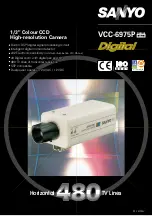
x32 electronic sensitivity
When the illuminance of the monitoring point drops down,
electronic sensitivity can be automatically increased to x32
(max.) to brighten up the image. The minimum illuminance on
the object is 0.05 Lux (using F1.2 lens) which makes it possi-
ble to obtain a clear picture with almost no light at all.
The automatic increase in gain can be set to x2, x4, x8, x16,
or x32.
The camera can even cope with a gradual and continuous
change in illuminance from day to night and maintains a crisp
picture by successive adjustments of the auto iris, auto gain
control, and electronic shutter.
High quality image with DSP
The adoption of a new DSP (Digital Signal Processor) has
brought up the quality standard of the monitored image for reli-
able surveillance.
1) By digitizing the Colour processing, Colour reproduction has
been largely enhanced.
2) DSP maintains crisp borders and also restricts smear and
smudges of Colour. It further enables a wide choice of set-
tings to control the degree of edge compensation.
On-screen settings
Camera settings can be easily controlled through on-screen
menus. A new setting will be reflected on the monitor to make
optimum settings easy.
Menu languages built in: English / French / Germany
x8 digital zoom with digital pan and tilt
Digital zoom of x2, x4, and x8, or continuous zooming up to x8
is available. The center of zooming can also be moved around
in all directions. Zooming can be controlled via SSP or by
means of a remote control circuit.
Two types of backlight compensation with fine tuning
1) Multi-spot photometry mode setting
This mode enables the user to specify screen areas, among 32
blocks, in which illuminance measurements will not take place.
The picture display will be kept to optimum brightness accord-
ing to the illuminance measurements obtained in other areas.
2) 5-section photometry mode setting
The screen will be divided into 5 sections to which the user
will assign 15-scale weights.
The brightness of the picture will be kept at optimum by giving
priority to the area with the higher weight. (A DC type auto-iris
lens is required to enable this mode.)
Three types of white-balance adjustment
1) Automatic tracking mode to adjust white-balance as the light
(Colour temperature) at the monitoring point changes.
2) Push-and-lock mode to adjust white-balance when the set
button is pushed.
3) Manual white-balance by adjusting R and B volume.
Camera ID display
An 8-character (max.) camera ID can be super-imposed on the
monitor. The user can change the display to any position on
the screen.
Three types of synchronization
Internal, line lock, or external sync. can be selected. Selection
= between internal and line lock sync. mode is done
on-screen. The camera automatically switches to external
sync. mode by receiving a VBS. (Line lock sync. mode is avail-
able only with 24 V AC power supply.)
Dual power operation
24 V AC or 12 V DC applicable.
13 mode electronic shutter
Short mode: 1/50, 1/120, 1/250, 1/500, 1/1000, 1/2000,
1/4000, and 1/10000 sec.
Long mode: 2/50, 4/50, 8/50, 16/50, and 32/50 sec.
1/3" CCD image sensor with approx. 470,000 picture elements
480 TV lines of horizontal resolution
Electronic iris (indoor use)
SSP (RS-485) compatibility
The whole security system, including the VCC-6975P, may be
controlled by a VSP-7000 system controller using a new com-
munication protocol SSP (Security Serial Protocol).
Remote control functionality on VSP-7000 includes all
on-screen menu items of the VCC-6975P.
System Controller VSP-7000 (sold separately)
When the electronic sensitivity is set to ON
Areas in which illuminance will
not be measured
SSP: Bi-directional communications (half duplex)
Maximum cable length for communication up to 1200 m (4000 feet)
An example of weight setting:
Top = 1, Bottom = 5, Left = 10,
Right = 10, Center (fixed) = 15.
The size and position of the cen-
ter area is adjustable.
1
15
10
10
5
1
15
10
10
5
Features
Security Serial Protocol
S S P
Command
Alarm
Multiplexer
VCR
VSP-7000
Up to 256
devices
VCC-6975P
VCC-6975P
VCC-6975P
VCC-6975P






















